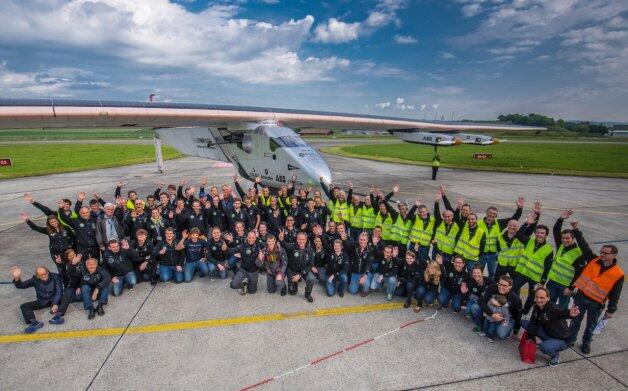After successfully completing the historic flight across the Atlantic on Thursday morning, the pilots flying Solar Impulse-2 (Si-2), the first solar plane making a round-the-world trip, are celebrating several world records.
With Swiss adventurer Bertrand Piccard in the cockpit, the plane landed at the Seville Airport in Spain at 7.38am local time on Thursday (UAE time 9.38am) after three days and three night’s flight (71 hours and 8 minutes) that took off from New York early on Monday. The flight, flying at a maximum altitude of 8,534 metres (28,000 feet) and average speed of 95.10km/h (59mph), covering a distance of 6,765km, completed the first ever electric, solar and emission-free transatlantic flight while breaking several world records (pending approval from relevant authorities), according to Solar Impulse, the Swiss organisation that initiated the pioneering project.
The records include distance and altitude in the electric aeroplane category as well as distance along a pre-declared performance in the solar aeroplane category.
This is the second historic moment Solar Impulse-2 is celebrating since the plane started its round-the-world trip from Abu Dhabi in March 2015. Piccard’s partner and co-pilot Andre Borschberg had piloted a 6,437-kilometre flight between Japan and Hawaii that lasted 118 hours, breaking the previous record for the longest non-stop journey in aviation history.
The pilots who take turns on each leg are eagerly waiting to reach Abu Dhabi early July. “We are excitedly waiting to reach Abu Dhabi by early July and celebrate the completion [of the first round-the-world trip of solar plane] with all of you [UAE residents],” André Borschberg told Gulf News on phone from the Mission Control of the Si-2 in Monaco. The Si-2 will fly to Morocco in the next leg and start its final journey to Abu Dhabi from there.
Borschberg said the Si-2 received more media coverage than expected, which helped create unprecedented awareness about the potential of clean energy. The UAE, an oil-producing country, supporting such a project gave an effective message to the world that future belongs to clean energy, he said.
Piccard interpreted his historic Atlantic crossing in a new perspective. “The Atlantic has always revealed the transitions between the ‘old’ and the ‘new’ worlds. But while these worlds used to be geographical continents, today they are states of mind. The ‘old’ world is the world of inefficient polluting devices, depleting the Earth’s resources. The ‘new’ world is the world of modern clean technologies that can halve our global energy consumption, save natural resources and improve our quality of life. With this transatlantic flight, our aim is to inspire the adoption of clean technologies everywhere,” he said.
For centuries, the Atlantic Ocean has been a playground for explorers with diverse means of transportation. Last century, Charles Lindbergh accomplished the first solo transatlantic flight with his prototype aircraft The Spirit of St Louis, paving the way for the development of commercial aviation.
Source: Gulf News











